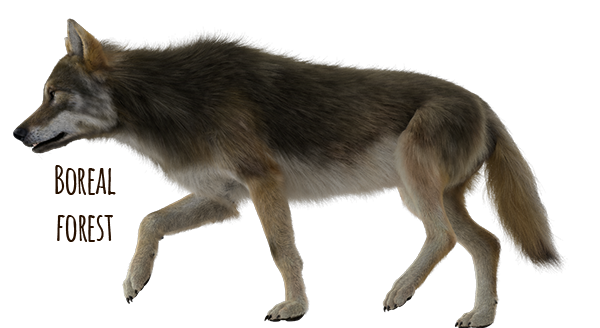Select Page
Boreal Forests - The Taiga
The boreal forest (also known as the taiga, a Russian word meaning swampy moist forest) is found in a nearly continuous belt across North America and Eurasia.
Most of Canada and Russia are covered by coniferous trees that make up this biome.
Boreal forests are the “dark and mystical forests” that form a thick green belt around the arctic circle.
The boreal forest biome is one of the largest, and most undisturbed land biomes on Earth. Making up 30% of all forests on the planet and covering somewhere between 10-15% of all land in the Northern Hemisphere, this forest is truly impressive. This biome is mainly defined by its long cold winters, domination by very few coniferous trees, huge amounts of fresh water, and common disturbances that create a mosaic of forests with different ages and structures that wildlife thrive in.
.
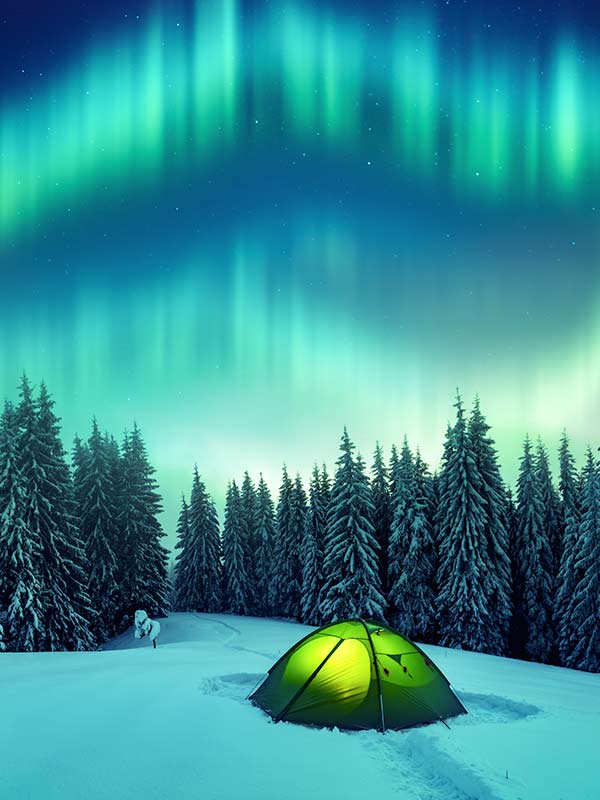
The Taiga
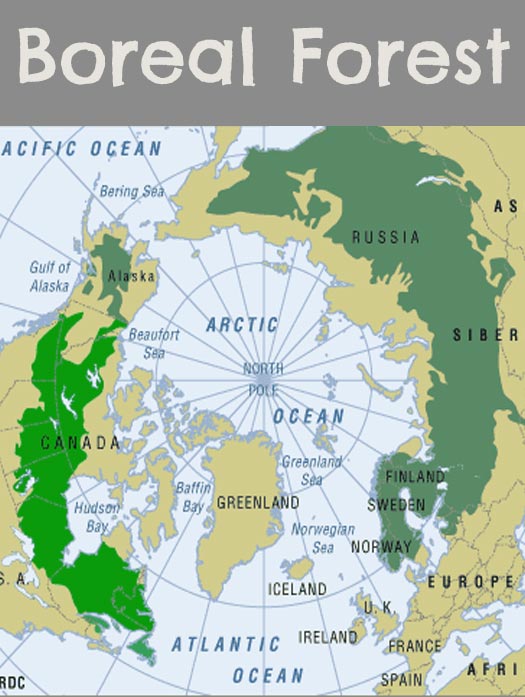
What defines the boreal forest biome? What is the climate of the boreal forest biome? What lives in the boreal forest? What adaptations do boreal forest plants and animals have that allow them to survive here? That’s what you’ll learn by spending a few minutes browsing this article and associated media.
Note: “Boreal forest” and “taiga” will be used interchangeably throughout this page because they are just two different names for the same biome!
WHERE IS THE BOREAL FOREST FOUND?
Based on the lines of latitude (the imaginary lines that run east and west on our planet), we can divide the world into three regions: Polar, tropical, and temperate. Polar regions are the most northern and southern (between 66° and 90° lat) , with temperate regions further towards the equator (23° and 66° lat) and tropic regions in the center (between 0° and 23°) surrounding the equator line.
The Boreal forests are found in the polar regions but are only located in the Northern Hemisphere of the planet, between the temperate deciduous forests to the south and the arctic tundra biomes to the North, at about 50°- 60° N latitude. This biome forms a dense belt of coniferous forest almost entirely around the arctic circle. This belt runs through Canada, China, Finland, Japan, Norway, Russia, Sweden and Alaska, USA. Luckily, a fair amount of boreal forest remains pristine, undeveloped and wild.
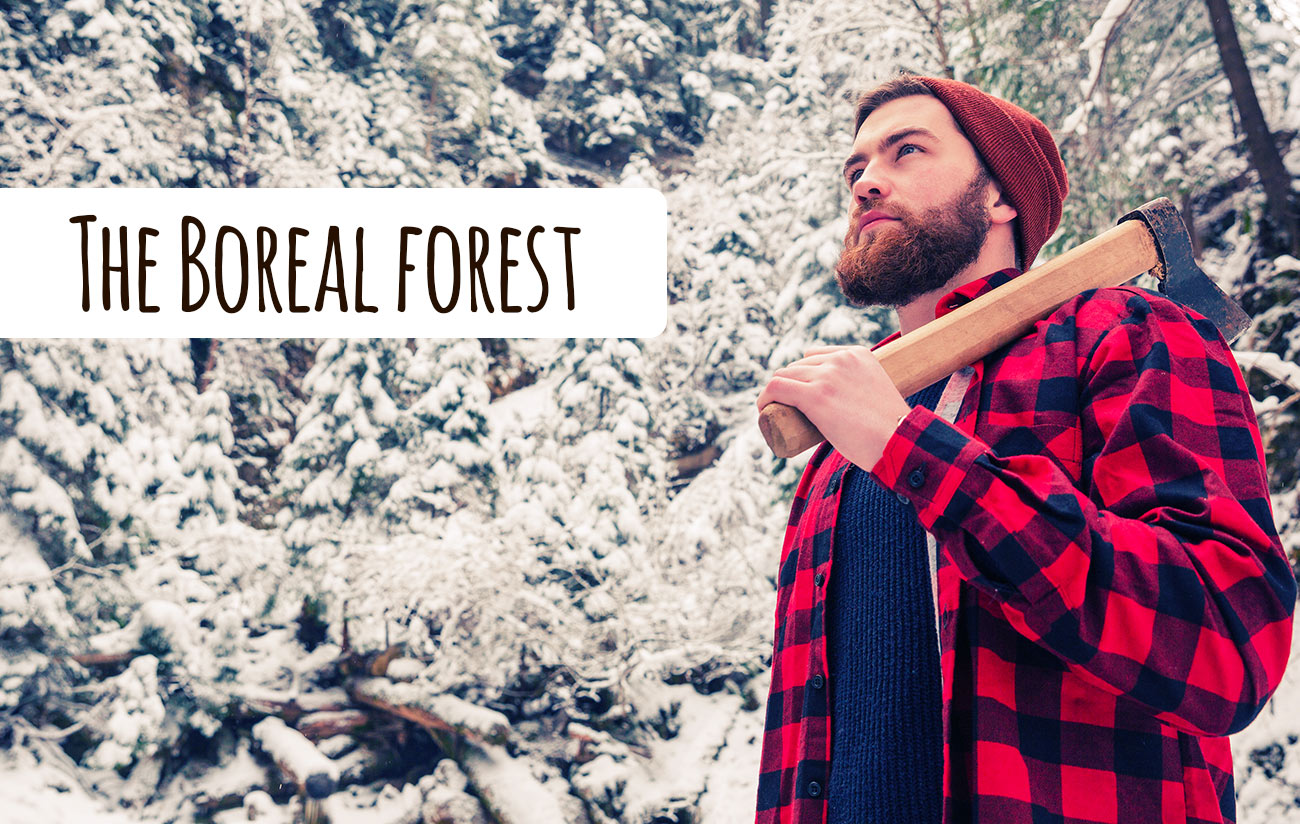
WHAT DEFINES THE BOREAL FOREST?
The boreal forest biome is defined mainly by its long cold winters and very low plant diversity, heavily dominated by only four types of coniferous trees. Over this large biome the growing season can be from 50-130 days, decreasing as you go North. As well, this region has low precipitation, meaning both rain and snowfall, but even lower evaporation and poor soil drainage, making it oddly the driest moist habitat on the planet. Innumerable bogs, swamps, lakes, and rivers dot the landscape between the thick forests, making up the largest reserves of unfrozen freshwater in the world. Another distinct feature of this biome is that it experiences frequent natural disturbances, mainly through fires and large pest infestations, which make a mosaic of older and newer forests; this heterogeneity is key to the biodiversity here, but more on that later.
The 4 seasons are very pronounced in the taiga, with long cold winters, mild springs and falls, and short but warm and productive summers. Since this biome is so immense, there are some differences in temperature, precipitation etc. depending on the region.
Before we break down each abiotic factor, or non-living component, of this biome we should note that within the boreal forest there are a few types and smaller eco-regions.
First off, we have evergreen taiga versus seasonal taiga. The majority of this biome consists of evergreen taiga that are dominated by evergreen coniferous pine, spruce and fir trees, while a large region in NE Siberia, the harshest area of boreal forest, makes up the seasonal taiga, which is composed of Siberian larch trees (Larix sibirica) These trees actually lose their pine needles in the winter just like leaf-bearing deciduous trees.
Wait a moment, what is the difference? Coniferous trees, or gymnosperms, are trees with needle-like leaves that reproduce via seed-bearing cones, whereas most deciduous trees have broad leaves, and reproduce using flowers – making them angiosperms. Most coniferous trees are also evergreen, meaning they do not seasonally drop their leaves. Larch trees are one of the few deciduous needle leaf trees.
Now, within this we also have light vs. dark taiga. Light taiga refers to the ecotone (meaning transition zone between two distinct ecosystems) where the boreal forest transitions into the arctic tundra, where fewer and fewer trees grow and the climate and soils make life much harder. The dark taiga refers to the ecotone where the boreal forest transitions into the temperate deciduous forest, where the climate and soil is more favorable, more and more plant life grows, and there are larger number of broadleaf deciduous trees mixed in with the coniferous ones. The “dark” vs. “light” here refers to how much light gets through the tree canopy down to the forest floor, based on how much plant life there is.
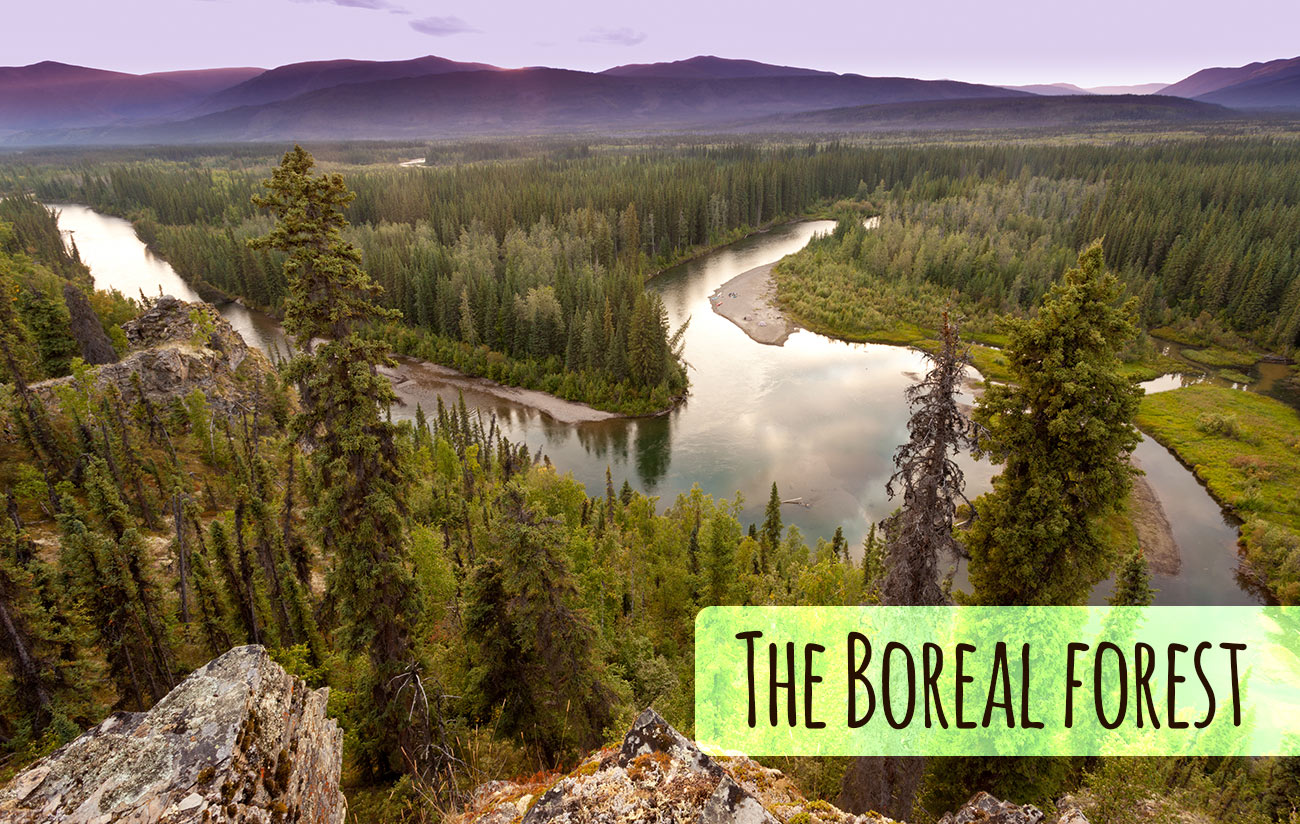
Temperature in the boreal forest
The year-round average temperature is from −5 to 5 °C (23 to 41 °F), but in extreme places like Siberia the yearly average is closer to -10 °C (14 °F). There is strong seasonality with a large difference between summer and winter temperatures:
Cold winters are the defining abiotic factor of the boreal forest. They can last from 5-8 months, depending on how far north you are, and have an average temperature of −20 °C (−4 °F) ranging (in general) from -1 °C (30 °F) to -50 °C (-58°F).
The summers are short but warm, with temperatures from 7 °C to 21 °C (44 °F to 70 °F), an average summer day could be around 18 °C (64 °F).
We can best illustrate the extreme differences again in NE Russia, where summer temperatures have reached 40°C (104 °F) and winters have dropped all the way to -62°C ( -79.6 °F)!
Precipitation in the boreal forest
There is not much precipitation in the boreal forest, only around 40-50 cm (15-20 inches) a year. In some regions, a lot more precipitation falls, reaching up to 100 cm (39 inches). Most of this falls as rain in spring and summer, but a fair bit falls as snow in the winter.
Despite this, cool temperatures also make for low evaporation, meaning that these areas still keep a fair bit of moisture. This is what we mean by “the driest moist biome” because it rains as little as a desert, but retains most of its water throughout the year.
This unique climate is the result of 2 different air masses that arrive in this region. An air mass is like a big “bubble” of climate that carries air and moisture from one area of the world to another via wind currents. For example, an air mass will form in the arctic, where it is cold and dry, and will be carried down to the boreal forest in the winter time, whereas in summer, air masses from the pacific bring in warmer weather and rain. This dynamic helps to create these cold and dry winters and warmer wetter summers that make this biome so unique, and difficult to survive in.
A lot of water accumulates here in swamps, bogs, lakes, and rivers. So much that the largest amount of unfrozen freshwater is found within this biome. There is not as much snowfall as rain, but snow is actually very important to a lot of life here, as it keeps the ground warmer, and allows for many animals to burrow in for warmth on the coldest days.
Sunlight hours of the boreal forest
Since the boreal forest is so far north, it experiences drastic differences in the amount of sunlight hours depending on the season. Though slightly less extreme than the arctic tundra or polar ice caps, summers have very long days, where at the peak of summer the sun sets for only a few hours, and on the other hand, in deep winter, the sun only rises for a few hours.
Because of the large number of coniferous trees that grow quite densely, very little light manages to reach through the canopy down to the forest floor, making it even harder for other plants to survive these difficult conditions.
Soils of the boreal forest
Soils of the boreal forest are low in nutrients, thin, sandy and very acidic.
The soils in the taiga are known as podzol or spodosol soils, coming from a Russian word translating to “under ash”. Spodosol soils are very harsh sandy soils that are found underneath a thin layer of organic material. Water leaches through this first layer very quickly, taking with it all of the nutrients, as well as sandy quartz material and metals like aluminum, forming a nutrient poor clay layer underneath. This grey layer gives the soil its name.
Parts of the soil are also waterlogged due to high shading of the forest floor by trees increasing already low evaporation, and patchy permafrost and bedrock that prevent water from draining out. In areas where excess water accumulates, you get swamps and muskeg or peat bogs which we will discuss more in the plant adaptations section.
Cold temperatures, high soil moisture, and low plant biomass, meaning the total amount of plants in a region, lead to poor decomposition and low nutrient cycling. Additionally, hard-to-decompose pine needles form a mat over the soil, further slowing this process and causing inhospitable conditions for a lot of soil invertebrates, making decomposition and soil formation even slower.
Additionally, these needles from the coniferous trees essentially poison the ground through a process called Podzolization. When needles die and fall off, the high concentration of resins, oils and other chemicals in the needles, that can help prevent them from freezing, leach into the soil making it inhabitable for many types of plants, helping trees to limit competition for nutrients and water.
Overall, there is a very low biodiversity of shrubs, grasses and even trees here because the species that can live here have to be specially adapted to survive in these harsh soils that have an extremely slow turn-over rate of nutrients.
Soil Layers:
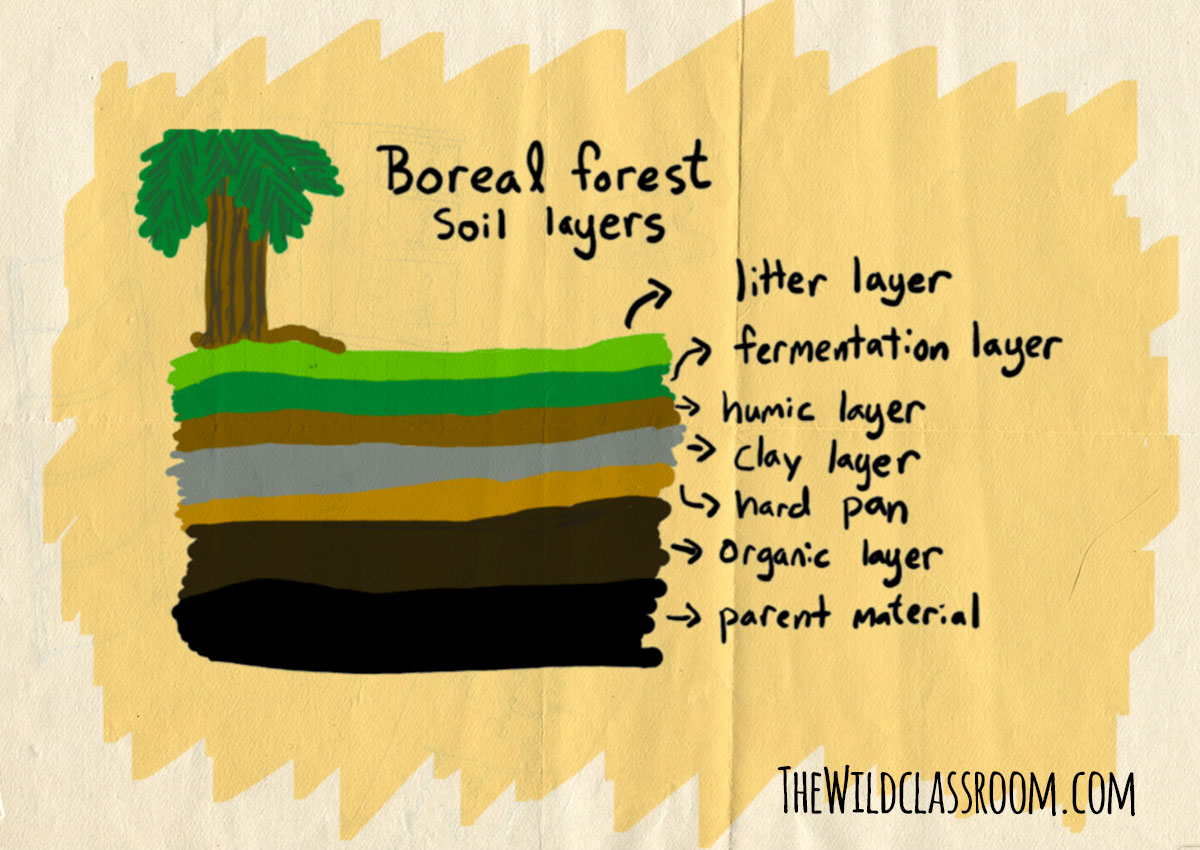
Frequent disturbance – Fire and pests
Another defining feature of the boreal forest is that it experiences frequent disturbances which create an interesting patchwork of older forests, disturbed forests, and newly recovering forests. After a severe disturbance, this succession goes from a “pioneer” community state up to “climax” communities.
In the extreme case that all plant life is wiped out, which is not all too frequent, the pioneer community will have lichens and mosses, then successional communities will gradually see subclimax plants like larch, tamarack and birch, later to be replaced by furs, spruces and pines. However, many times disturbances are small enough that they do not kill off a lot of plant life, they actually just help to clean up the forest, especially in the case of fire.
Fires are frequent in the taiga and are very necessary to help regenerate forests. When a fire goes through an area it helps to (1) get rid of old dying trees. (2) Clean up dead brush and burn up organic material – this makes nutrients available to other plants. (3) Helps some trees, such as jack pine (Pinus banksiana) and lodgepole pine (P. contorta), to reproduce – because their cones are serotinous, meaning they actually need fire to open cones and activate the seeds. (4) Helps other types of plants and saplings to grow from new gaps made in the canopy, which helps with overall biodiversity. Not only does fire help plant species, but it also increases overall animal diversity because some animals are more successful in older forests, such as woodland caribou (Rangifer tarandus caribou), woodpeckers, and the boreal chickadee (Poecile hudsonica), and others in newly burned ones, like moose (Alces alces) and the mourning warbler (Oporornis philadelphia).
Here is a set of videos for understanding forest fires, especially in forests that depend on fire.
As well, insects that bore into trees for food, and to make galleries to cultivate fungus and lay their eggs, such as the spruce bark beetle (Ips typographus) and various other species from the subfamily scolytinae, kill off older trees and help open the canopy for younger trees. Unfortunately, large numbers of these beetles can cause devastation to some forests, especially if there is an infestation during some stress, like a drought. If trees are in poor conditions they are not able to spare the energy to release toxins and defend themselves as well and even younger trees may not be able to survive attacks from large populations of insects.
THE BOREAL FOREST THROUGH TIME
In relative terms, the boreal forest biome is quite young, especially in its current location. Throughout geologic history, glaciers from the north pole have grown and shrunk substantially (very slowly over millions of years though) and have shifted the position of the taiga. Around 20,000 years ago, when the ice sheets were the biggest, the boreal forest was actually ice caps and arctic tundra, and our temperate deciduous forests would have looked more like boreal forest. Once the glaciers retreated the boreal forest shifted further north.
The fact that these trees, and the animals that live among them, have had to evolve to this flux of habitat on the border of the ice caps over thousands of years is part of what has made them so resilient and cold adapted, and make the taiga such a huge biome, because these dominating coniferous trees can live in a range of difficult climates.
As well, encroaching and retreating glaciers is what has formed the complex landscape, with lakes, swamps, bogs, valleys and hills, that creates this diverse habitat.
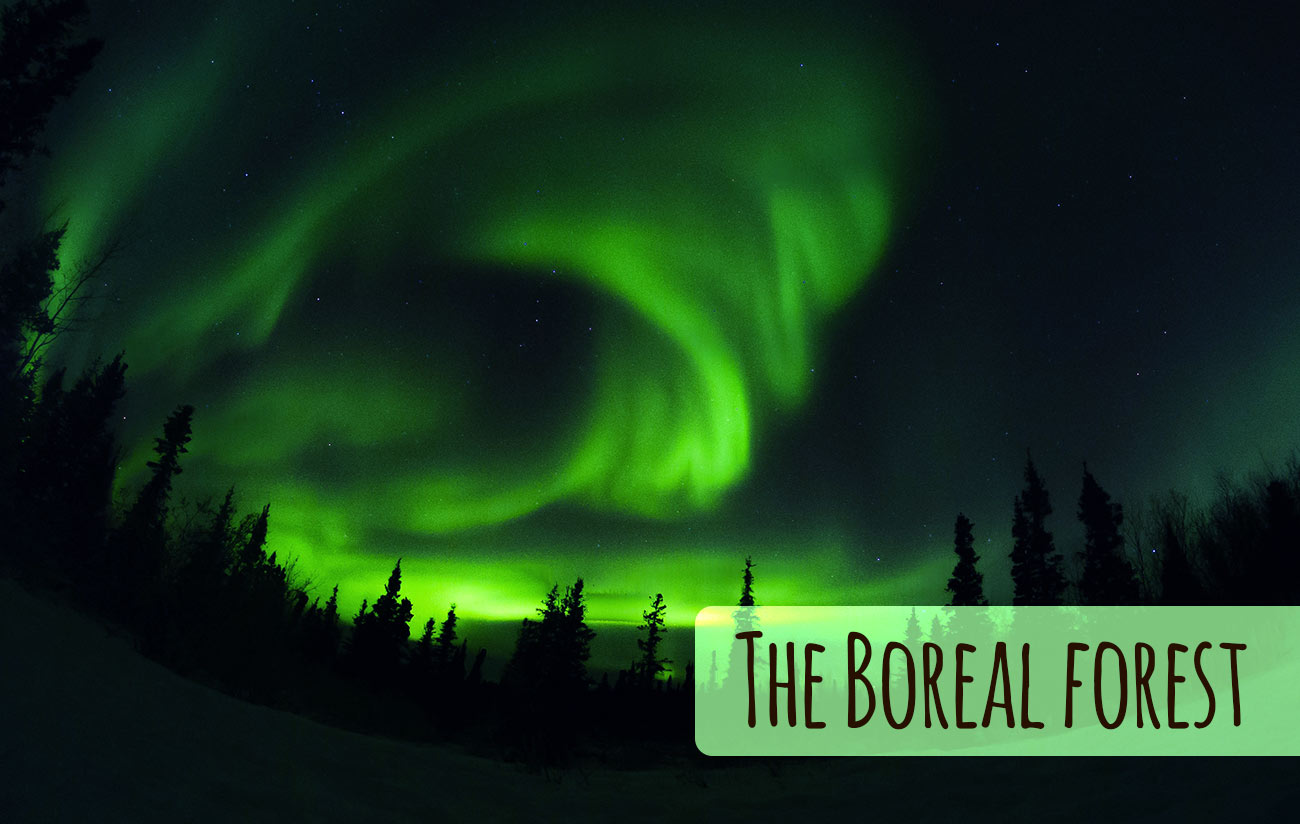
BIODIVERSITY IN THE BOREAL FOREST
What lives in the boreal forest biome?
In terms of plant life, this biome is extremely low in diversity, but there are quite a few animals that live here. The harsh abiotic conditions here make this is no easy place to live, resulting in a domination of a few key types of trees, some resilient shrubs and grasses, and mosses and lichens. Despite low plant diversity, there is a variety of animals that call this biome their home, including a massive amount of birds that migrate here to breed and nest in the summertime.
The harsh soil conditions result in much fewer soil invertebrates than in other biomes, meaning that fungi mostly take on the important role of helping with decomposition here, though there is a high variety of flying insects, especially those that lay their eggs in still water, such as mosquitos.
So what kind of adaptations do boreal forest plants and animals have that help them to survive in these difficult conditions?
Plant adaptations to the the boreal forest
Similar to the temperate grasslands, this biome is dominated by only a few plant species. There are only 4 tree genera that dominate this biome: pine (Pinus), fir (Abies), evergreen spruce (Picea), and deciduous larch AKA tamarack (Larix). There are also a few broadleaf deciduous trees that live here but in much smaller numbers: alder (Alnus), birch (Betula), and aspen (Populas).
Though it varies across the landscape, in general, in North America, a few species of fir and spruce are dominant, while through Scandinavia and western Russia the Scots pine (Pinus sylvestris) is common. Last, in the evergreen taiga larch trees are mainly found.
The cold adapted coniferous trees that dominate here have the following key adaptations:
The conical shape of these trees, smaller branches up top and wide ones further down, helps the snow to distribute more evenly across the tree and also to fall to the ground and prevent branches from breaking from the weight.
The thin needles have less surface area and waxy cuticles to avoid water loss in the dry winds and in winter when most available water is frozen. As well, the dark color of the needles helps to absorb more of the sun’s heat and stay warm. Last, the needles are also full of resins and other chemicals to help them from freezing. As talked about above, these needles also help reduce competition by causing an inhospitable environment for other plants. This adaptation is called allelopathy.
They have very shallow roots compared to other trees, for example,Black spruce trees have been found growing in soil only 50 cm (20 inches) deep!
The short growing season makes it difficult to drop leaves and regrow them in time for summer, so by keeping their needles all winter, evergreen trees can start to photosynthesize as soon as it warms up, without having to wait for new leaves to grow.
However, in the most extreme cold and dry, like in Siberia, this trade off doesn’t work, because keeping leaves through winter takes too much energy, so larch trees that live here are deciduous, dropping their needles during the deep winter in order to go dormant and not waste energy trying to keep their leaves alive and retain water.
The deciduous angiosperm trees that live here are fewer in number but have found ways to survive. They are found in bigger numbers further south where conditions are less harsh, but are spread throughout the rest of the forests too. Often they are more common in successional areas that are recovering from a disturbance, where the more successful gymnosperm trees have not had a chance to establish yet, or near water bodies. The adaptations they have to survive here include some of these examples:
Many of them are able to live in more waterlogged soils that coniferous trees have a harder time surviving in, so they take up this unused niche and have less competition.
Aspens actually have some chlorophyll in their bark, so they can photosynthesize small amounts in winter and in early spring while waiting for their first leaves to grow in.
Alder trees have bacteria-filled nodules in their roots that help them to convert nitrogen into food when they are not able to photosynthesize, and for additional food while they can.
After trees, mosses and lichens are the most common. Lichens are actually an interesting symbiotic relationship between a fungi and algae, where the fungi provides a sturdy base and protection for the algae, while the algae photosynthesis and makes the energy. Lichens can grow both on trees and on the ground and are extremely hardy, living in the worst conditions world wide. Moss doesn’t need thick well developed soils, nor very much light, absorbing most of its water from the air, and being able to go dormant during very dry conditions, it survives well here. In many regions moss grows so thick that it carpets the ground (another thing keeping moisture in the soil) and prevents a lot of other plants from growing through taking all the available space on the forest floor, this is known as spatial dominance.
Grasses, some flowering plants, and shrubs make a living where they can. Shrubs such as rowan (Sorbus), blueberry (Vaccinium), high-bush cranberry (Viburnum), and low-bush cranberry (Vaccinium vitis-idaea) can be common. These plants grow close to the ground, have thick waxy leaves to prevent drying out, and reproduce by making brightly-colored and tasty berries that are eaten by birds and mammals that disperse the seeds by moving around and later expelling them with their waste.
Things such as willow bushes (Salicaceae) and wild rose shrubs (Rosa acicularis) survive frequent fires through their ability to regrow from unburnt rhizomes, which are like an adapted root that helps the plant grow outwards underground. Other plants, such as aspen trees or fireweed (Chamaenerion angustifolium) have winged or parachute like seeds that can be carried away on the wind and land in unburnt areas. As mentioned before, many coniferous trees, like jack pine (Pinus banksiana) as another example, are serotinous and need fire to activate their seeds. This allows the seeds to start to germinate after an area has been cleared of deadfall and other competing plants, and lots of nutrients are newly available in the ash, giving them a better chance to grow.
An amazing adaptation to survive low nutrients is found in plants like pitcher plants (family Sarraceniaceae in the new world and Nepenthaceae in the old world). These plants are carnivorous, luring various arthropods into their pitcher-like flowers and digesting them in strong acids.
In open areas free of trees and filled with water, you will find muskegs or peat bogs. Here, Sphagnum moss grows, absorbing an incredible amount of water (30 grams (1 ounce) of dry sphagnum can hold about ½ liter (1 pound) of water!). This creates a thick spongy mat where cotton grass (Eriophorum) and shrubs can grow on top. As the mat grows, old moss dies and decomposes underneath, but extremely slowly, making these areas super important for carbon storage. This semi-decomposed material is called peat, which also gives these areas their other name of “peat bog”.
Eventually, enough peat can form that trees will even take root here and it will transform into a forest. This is a slow process though, not only because of slow decomposition, but because these areas are even more acidic and low in oxygen than the poor soils around it. Before trees move in, you can find more resilient plants that are adjusted to these conditions, like the various berry-bearing bushes mentioned earlier.
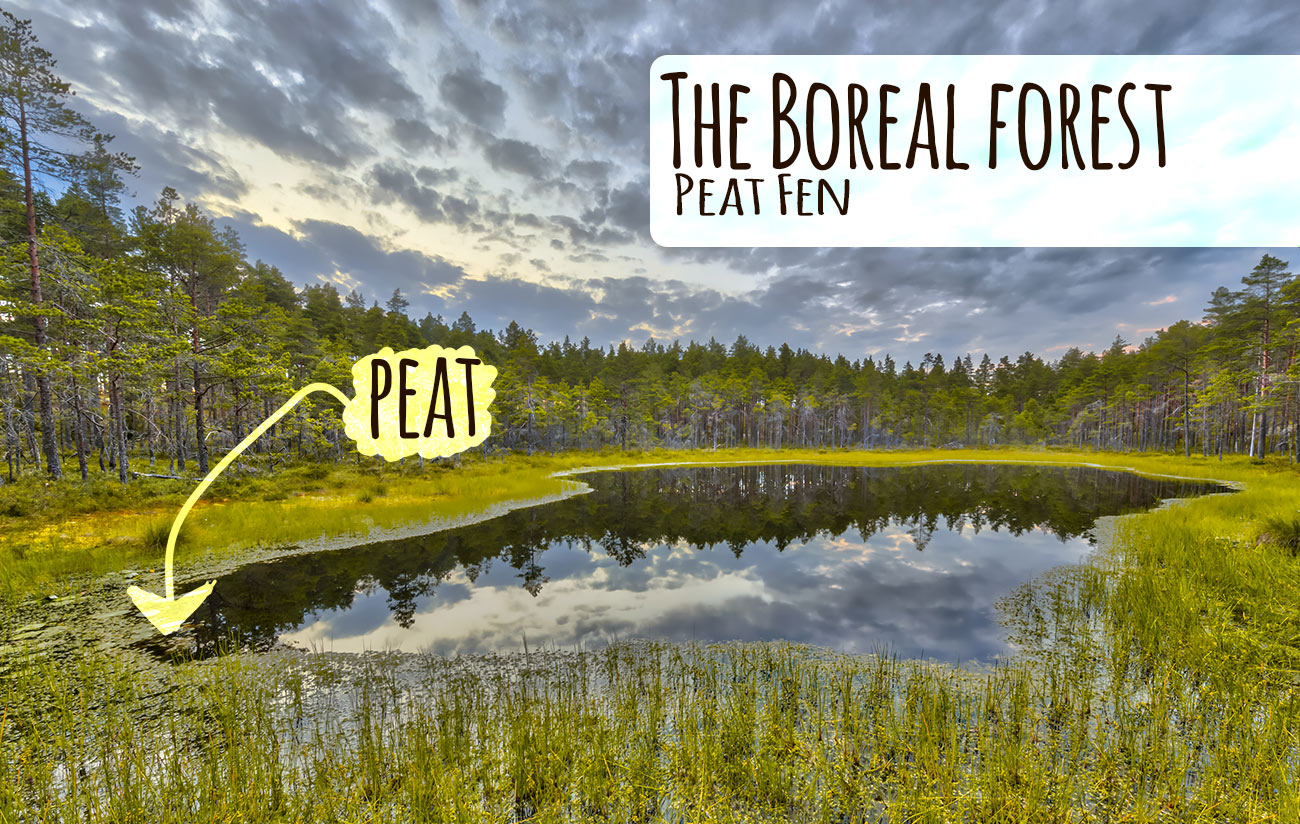
Animal adaptations to the the boreal forest
Although plant diversity is low, many animals make a living in this difficult environment. Similar to many cold biomes, a large amount of the biodiversity here is from migrant animals, ones that only live here in spring and summer and leave to spend the fall and winter in southern more hospitable climates, however cold adapted resident animals make the taiga their home all year round.
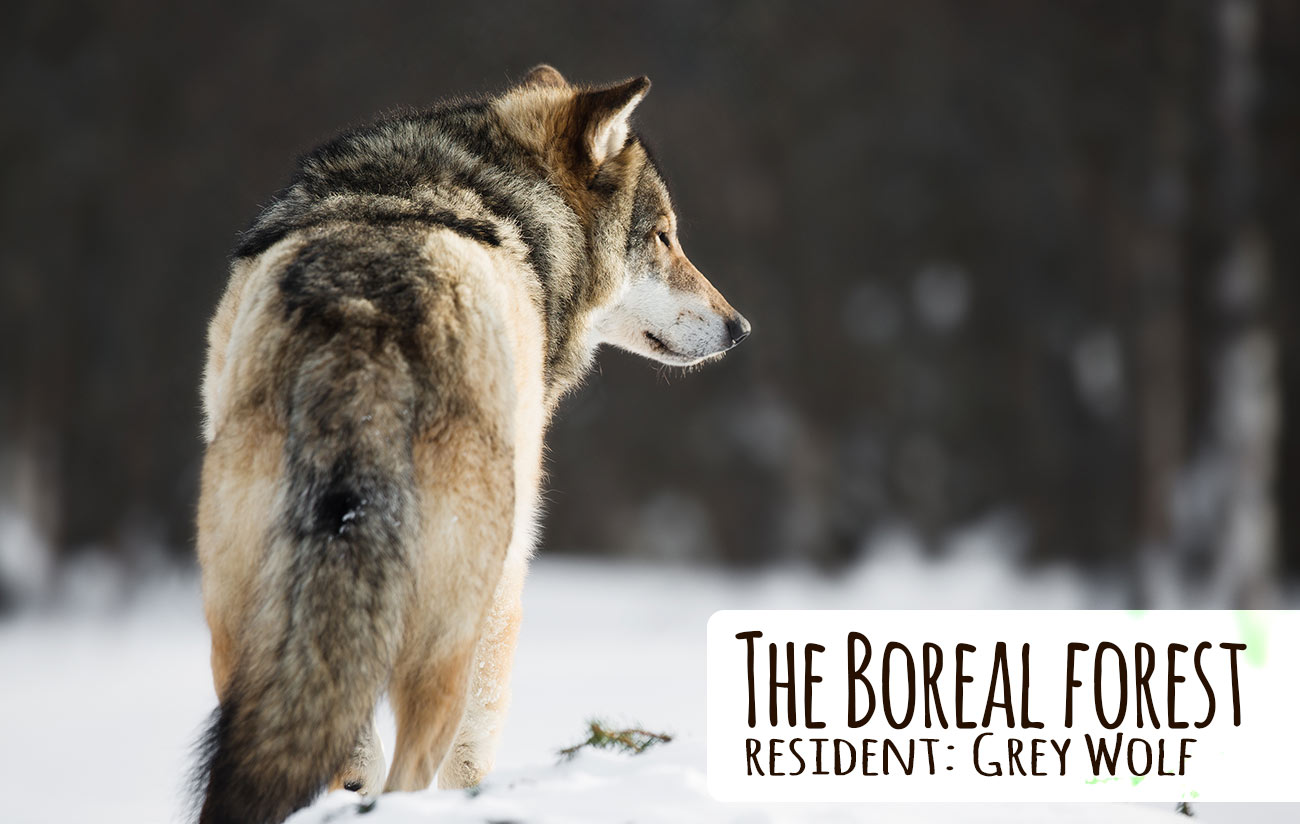
Residents
In the case of mammals and birds, adaptations to survive in the taiga are similar to those you will find in arctic or even alpine tundras, but they have to deal with stronger seasonality and warmer summers as well.
Large mammals such as moose, woodland caribou, Wood bison (Bison bison athabascae), Red deer (Cervus elaphus), Wild boar (Sus scrofa), bears (Ursus), and more, as well as smaller mammals like the red squirrel (Tamiasciurus hudsonicus) have many ways to deal with harsh winters:
They have very round, and often large, builds, which means less surface area to lose heat, shorter ears and tails (though not as pronounced in the tundra), very thick insulating fur/feathers, feet that are wide (also with thick fur/feathers) that help them walk on the snow, and the ability to create fat stores in summer to help them last through, and stay warm during, the winter. Caribou hairs are not only thick but also hollow, which helps insulate them even further!
Another useful strategy is to change coats between summer and winter. Snowshoe hares (Lepus americanus) for example not only grow much thicker fur in the winter, they also change the color from dark browns to white, and vice versa, to better help them camouflage, no matter the season. Snowshoe hares are a very important prey source for many taiga predators, such as the lynx (Lynx sp.), and need to do the best they can to avoid predation. Lynx are a great example of wide feet used to walk on snow, their furry and huge paws act as “snowshoes” to help them save energy by not having to plow through lots of snow.
Some animals, such as black bears (Urus americanus), and many rodents, like jumping mice (Subfamily Zapodinae), hibernate through the winter in order to avoid it all together. Hibernation is the act of lowering body temperature and metabolism to stay asleep for long periods of time. Small animals that do not hibernate, like voles, spend most of their time underneath the insulating snow to keep warm.
Amphibians, reptiles, like the garter snake (Thamnophis), and even some insects also take on similar strategies, though heterothermic ectotherm animals, those whose body temperature changes with the environment, go through something called brumation.
See this article for the difference between hibernation, brumation, and estivation.
Perhaps one of the most iconic, and extreme, examples of brumation is the wood frog (Lithobates sylvaticus), which actually allows almost its entire body freeze over winter, and is able to thaw and continue to live the next spring. Many insects, like mosquitos, in these northern climates also freeze and thaw in the winter.
Other frogs and turtles brumate at the bottoms of ponds and lakes, letting their temperature get very low, so they remain in a semi-dormant state, requiring little food and oxygen, surviving even if their water body gets totally sealed off by ice. Fish such as lake trout (Salvelinus namaycush) and northern pike (Esox lucius) have similar behavior though they remain more active than turtles.
Curious how some species of turtles breathe while underwater in winter?
Large predator species like the Siberian tiger (P. tigris) and grey wolf (Canis lupus) rely on incredible senses and endurance to track down and hunt prey in the cold winters. Wolves also have the behavioral adaptation of being social animals, and hunting together to allow them to hunt and kill larger prey species.
Though the majority of bird life here is from migrants, many birds live here year round, especially those that are omnivorous like the raven (Corvus corax), or eat seeds and buds like ptarmigans or different finches, sparrows. crossbills, and the black-capped chickadee (Poecile atricapillus), whose specialized black and white feathers absorb heat and keep it warm. Many of these birds rely on pockets of snow to avoid the worst cold at night, and some even have a strategy to store seeds in special throat pouches, to be able to feed and keep energy up when it is too cold to forage.
Migrants
The majority of migrant animals here are birds, and so many come every year to mate and nest that it is actually referred to as North America´s bird nursery. Every year more than 300 species of birds, some 3-5 billion individuals, migrate here in spring, take advantage of the short productive summers, and head back South once again. Some examples are the Canada warbler (Wilsonia canadensis), Whooping crane (Grus americana), Pacific Swift (Apus pacificus), various thrushes and grosbeaks, and well, hundreds more. These birds need to be able to fly long distances in short periods of time and raise their young in one season, so that they can also travel south in the summer. Many species of birds make multiple stops along the way in order to complete the journey.
Check out this interactive map showing some habitats and migrations of North American boreal forest birds.
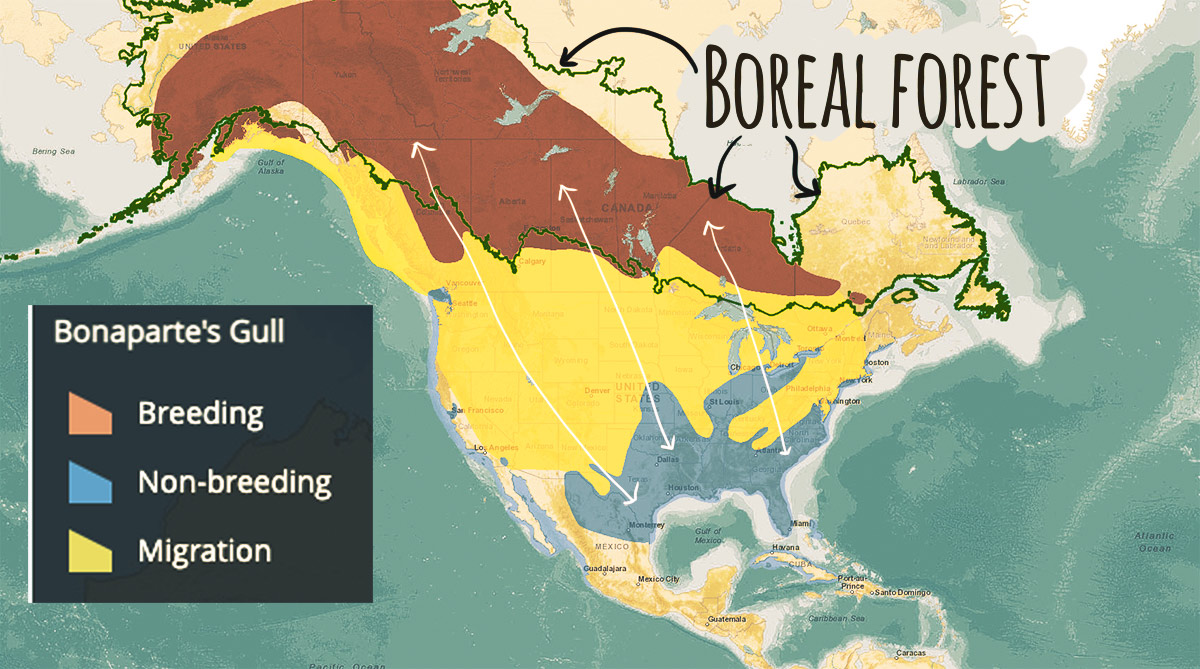
The other famous migrants of the boreal forest are salmon. Salmon such as chum (Oncorhynchus keta) and chinook (Oncorhynchus tshawytscha) hatch in freshwater streams, where they grow as much as they can before making their way down to the ocean. They then grow here for one or even a few years, depending on the species, and the adults migrate all the way up freshwater streams, sometimes 1000s of km to reach their original hatching ground, where they spawn and die. These events are very important for animals like bears and wolves as they feed before winter, and for riparian (river-side) plant life that receive a lot of nutrients from the ocean. As well, people that live here rely on salmon harvest during this migration.
Another notable migration is that of the monarch butterfly, read about them here.
Looking for even more examples of boreal forest wildlife? Here is a great page with plenty!
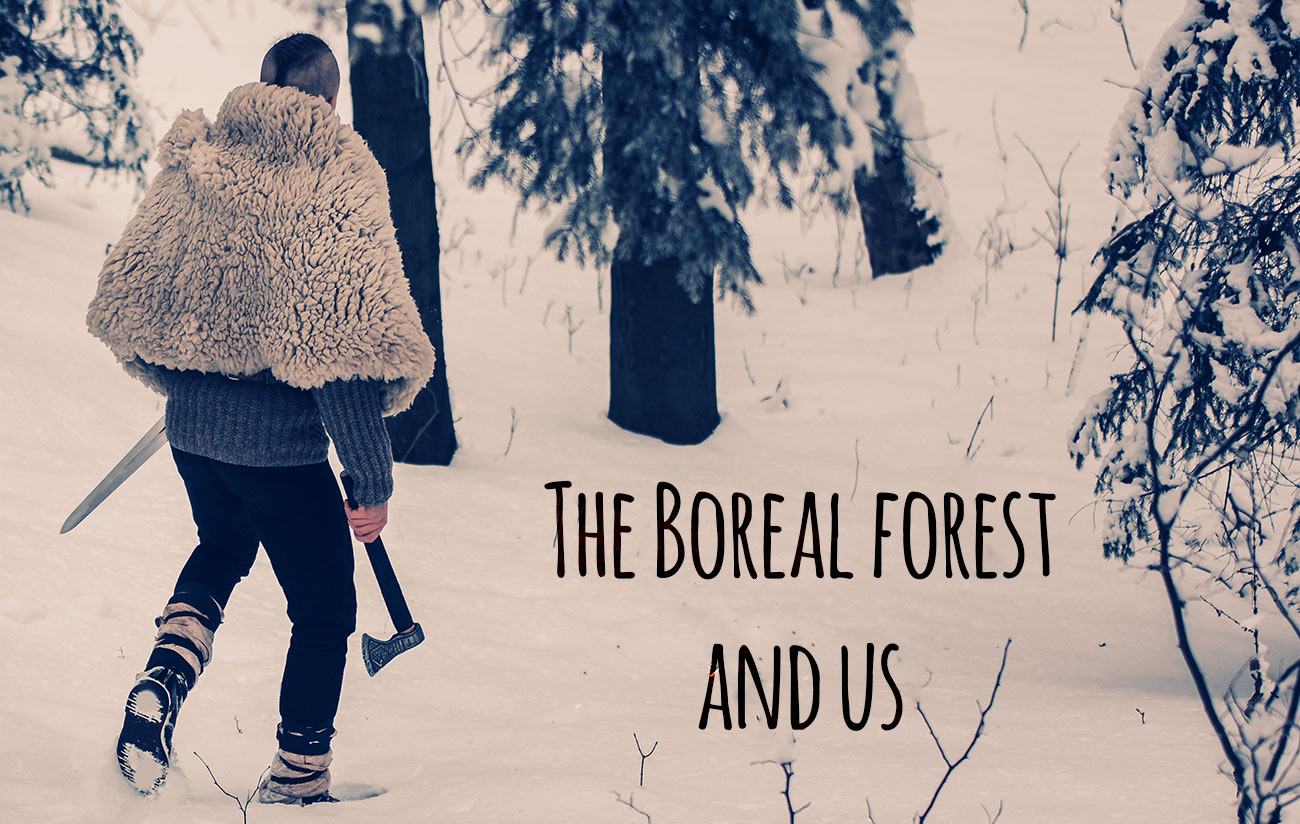
THE BOREAL FOREST AND US
The boreal forest biome takes up a large part of the Northern Hemisphere and is important to us in many different ways. Though the climate is harsh, many people live here and even more depend on the resources that we extract from it. Just as one example, in Canada, 70% of aborginial groups live in and depend on the taiga for their way of life, from hunting to use of important medicinal plants. There are of course various other indigenous groups across Eurasia as well. You can read here about the reindeer-herding peoples in Siberia and Mongolia.
As well, many non-indigenous people call the taiga their home and depend on it for lumber, hydroelectric power, fresh water, minerals, and for recreation. This biome is a big contributor to world biodiversity, mostly in terms of fauna. The boreal forest also plays an important role in world climate.
The boreal forest and world climate
Since the boreal first is so extensive, it plays a huge role in oxygen production and also in carbon sequestration. Interestingly, there are notable differences in world wide oxygen levels in winter that are linked to the lack of photosynthesis from the boreal forest in winter, which recuperate again every year in spring. As well, peat moss in swamps and muskeg forms thick mats that sequester huge amounts of carbon and that filter and clean water. Last, the dark colors of the boreal forest also contribute to temperature, as the huge expanse of dark needles absorbs the sun’s heat, causing warming.
Direct impacts on the boreal forest by humans
Logging and resource extraction are the largest impacts on the boreal forest, along with hydroelectric dams and pipelines. Surprisingly, about 1/3 of all lumber and 1/4 of paper comes from the boreal forest region.
Logging and resource extraction can be really devastating to the taiga when done by clear-cutting, where all trees are removed from an area. This is a cheaper and easier way to harvest lumber, but is not sustainable. When this happens, it causes a lot of habitat loss as well as fragmentation, where habitats are broken up, causing problems for wildlife that need large territories to survive, such as woodland caribou (Rangifer tarandus caribou), who in many places are extremely endangered.
Luckily, a lot of the resource extraction done in the taiga is done in a sustainable manner, that tries its best to mimic the natural disturbances that are so frequent here.
Hydroelectric dams can cause many issues with water, from heating up rivers, to flooding large areas of habitat with their reservoirs, and by causing huge barriers to migrating fish. Research is always being done on how to better these designs to have a lower impact on the environment, but we have some way to go.
Indirect human impacts on the tiaga / Boreal Forests
Just like much of our planet, the boreal forest is being changed by climate change, at a much more rapid pace than it has ever seen before. The main issues experienced are melting of permafrost which changes tree growth, expanding the taiga northwards while having many more deciduous trees grow in the south, and through changing temperatures, which can be drastic for many of these organisms that are already living on the limit of their physiology due to the difficult climate. Warming and drier weather can also increase wildfires, to the point where they are too frequent, and increase the ability for pest infestations.
As mentioned before, insects killing trees is a natural process but increased droughts and warming temperatures that have sped up their life cycle have really increased this problem. As well, in some regions introduced species, or even species changing their range with warmer temperatures, has made it so that trees are being attacked by insects that they are not used to defending against, which is extremely problematic.
Though the boreal forest faces a range of threats, it still remains one of the most intact and wild biomes in our world. Conservation efforts worldwide, and the fight to slow down climate change, are valiant efforts to continue to preserve these dark mystical forests, that despite the harsh conditions found here, are full of life.
Interested in research in the boreal forest? http://ibfra.org/
More about the boreal forest
Did you enjoy that 360° experience? If so, watch more.
